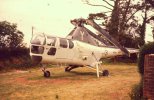T
Tom24
Guest
Does anyone know where the “Hay Mills Rotor Station” was located during the early 50’s. I recently came across a Civil Aircraft publication from 1951 which stated that B.E.A. were operating 3 flights a day from Hay Mills to Northolt aerodrome in London, using Sikorsky S51 3-seater helicopters.
The cost of the 70min journey was £2.10s single and £4.10s return, with an extra £1 for the onward flight to Heathrow.
Apparently, local M.P. Gerald Nabarro used this service regularly to fly down to Westminster, and spoke in support of it in the House.
There would have been a helicopter landing circle and some sort of control tower. At the time, they planned for a nationwide network of these stations, some being planned for the roofs of mainline rail stations in city centres, but presumably the idea never really “took off!” – possibly because of the cost. £4 must have been pretty much a week’s wages then.
Any ideas?
The cost of the 70min journey was £2.10s single and £4.10s return, with an extra £1 for the onward flight to Heathrow.
Apparently, local M.P. Gerald Nabarro used this service regularly to fly down to Westminster, and spoke in support of it in the House.
There would have been a helicopter landing circle and some sort of control tower. At the time, they planned for a nationwide network of these stations, some being planned for the roofs of mainline rail stations in city centres, but presumably the idea never really “took off!” – possibly because of the cost. £4 must have been pretty much a week’s wages then.
Any ideas?




